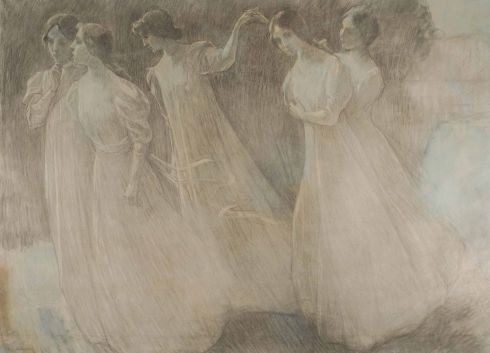Today I wanted to share some a beautiful and eerie fragment of an unfinished drama called “The Dance of the Consumptives” written by a rather obscure English poet Henry Kirke White (1785-1806) said to have been written n his earlier phase though I am not sure how old he would have been exactly because he died so young as it is. You can read the whole text of this eccentric unfinished drama here.
 Henri Le Sidaner, Ronde des jeunes filles, crayon graphite, 1897
Henri Le Sidaner, Ronde des jeunes filles, crayon graphite, 1897
These lines specifically have been haunting me for some time now, but now, at last, the perfect imagery came to my mind. The drama is about death arriving dressed as consumption to flush a young girl’s cheek and take her away to the other world. Dancing young girls in drawings of the French painter Henri Le Sidaner perfectly fit the mood of the drama. With their pale attire and fluid, ghostly forms they almost looks like ghostly maidens who fell prey to the consumption and have now arrived to welcome a new soul into their eerie, ghostly circle dance:
In the dismal night air dress’d,
I will creep into her breast:
Flush her cheek, and bleach her skin,
And feed on the vital fire within.
Lover, do not trust her eyes,—
When they sparkle most, she dies!
Mother, do not trust her breath,—
Comfort she will breathe in death!
Father, do not strive to save her,—
She is mine, and I must have her!
The coffin must be her bridal bed!
The winding-sheet must wrap her head;
The whispering winds must o’er her sigh,
For soon in the grave the maid must lie:
The worm it will riot
On heavenly diet,
When death has deflower’d her eye.

Henri Le Sidaner, La Ronde, c 1900




